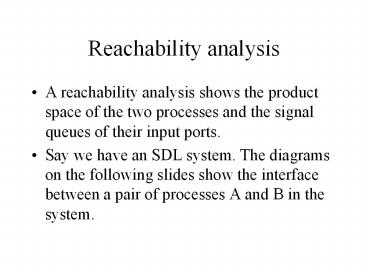Reachability%20analysis - PowerPoint PPT Presentation
Title: Reachability%20analysis
1
Reachability analysis
- A reachability analysis shows the product space
of the two processes and the signal queues of
their input ports. - Say we have an SDL system. The diagrams on the
following slides show the interface between a
pair of processes A and B in the system.
2
The SDL Block containing two processes
3
Two communicating SDL Processes
4
Reachability analysis (How to do a State Space
exploration)
- To perform the reachability analysis, the first
step is to transform the process graph into
transition charts. - In a transition chart, each input is prefixed
with a ? and each output by a !. - Each transition consists of either an input or an
output.
5
The Transition chart for the SDL Processes
6
State space exploration
- Assuming that there is a maximum queue size of 1,
this is the global graph for the transition
charts.
7
State Space exploration graph
8
Possible errors
- Unspecified receptions
- An unspecified reception occurs when a state in
the global behavior is scheduled to receive a
message that it does not know how to handle - Queue overflow
- This occurs when there is an attempt to put a
signal in a queue that is already full
9
Possible errors(continued)
- Deadlocks
- deadlocks can also occur when 2 or more processes
are unable to proceed because they wait endlessly
for signals from each other. - Livelocks
- livelocks occur when processes send signals
endlessly without making any progress.
10
Deriving role behaviours
- Now the global behaviour graph grows very
rapidly. - For large systems, we need to simplify the job.
- One method is deriving role behaviours.
11
Deriving role behaviours
- Steps to follow
- Mark the transitions that involve signals to and
from the environment with the special symbol ?.
These transitions are called invisible
transitions. - Find the set of nodes reachable from a given node
by following one or more ?-transitions (called
?-ambiguities) and group them together. - We have a reduced transition chart. Then, proceed
as usual.
12
The Modified Transition chart with ?-transitions
13
The Modified Transition chart with
?-transitions (without the ?-transitions)
14
The new State-Space exploration graph
15
Tau tool
- We can explore the state space by using the
validator in Telelogic Tau tool. - When a random walk is done, the tool will
randomly select a branch and move down the graph
until it reaches an unspecified reception,a
deadlock or the end of the graph (maximum depth
specified). It then selects randomly another
branch. - The following is the output given when the random
walk was done on the egg timer system.
16
Click here to Start the Bit-State or Random
Walk state space exploration or to go step by
step through the specification use the navigator
17
- A bit-state can also be done.
- The bit-state will attempt to find all the
possible outcomes from the top node. From these,
it will repeat the same operation and go through
their possible outcomes. - The following is the output of the bit-state
search in the validator.
18
(No Transcript)































